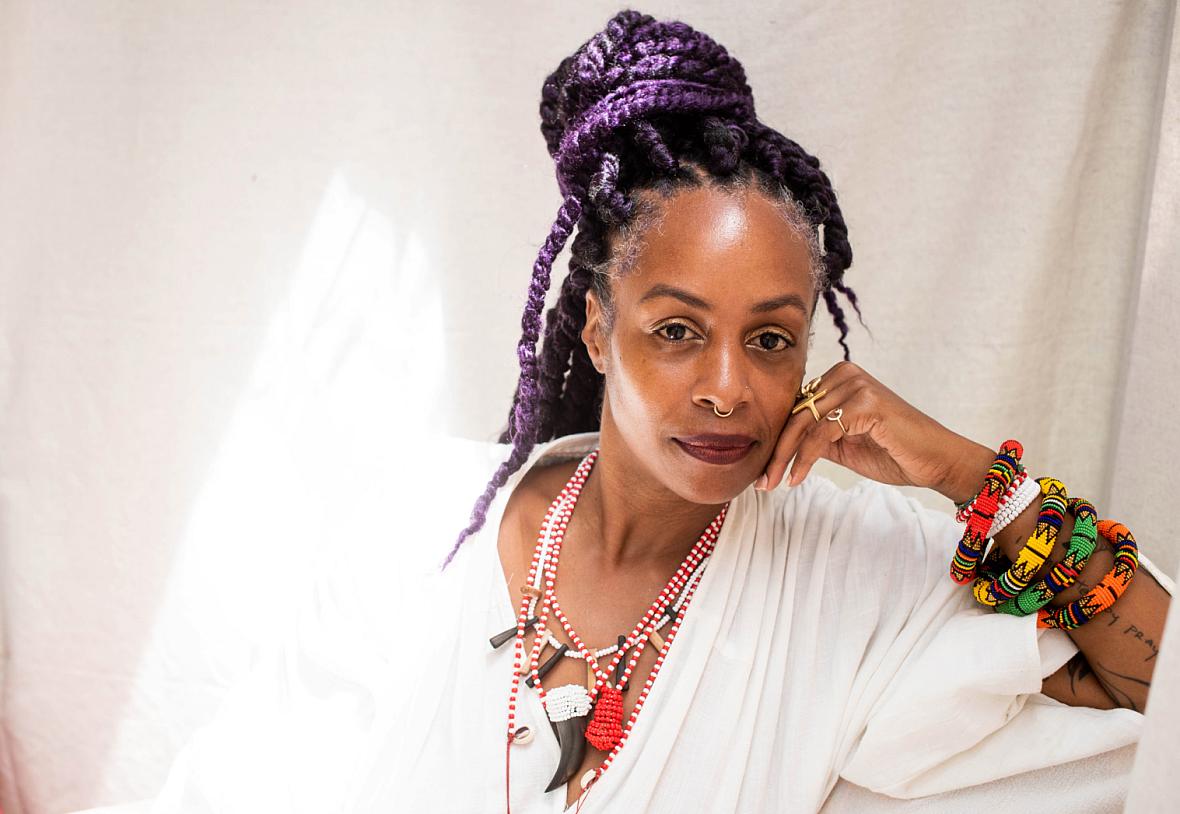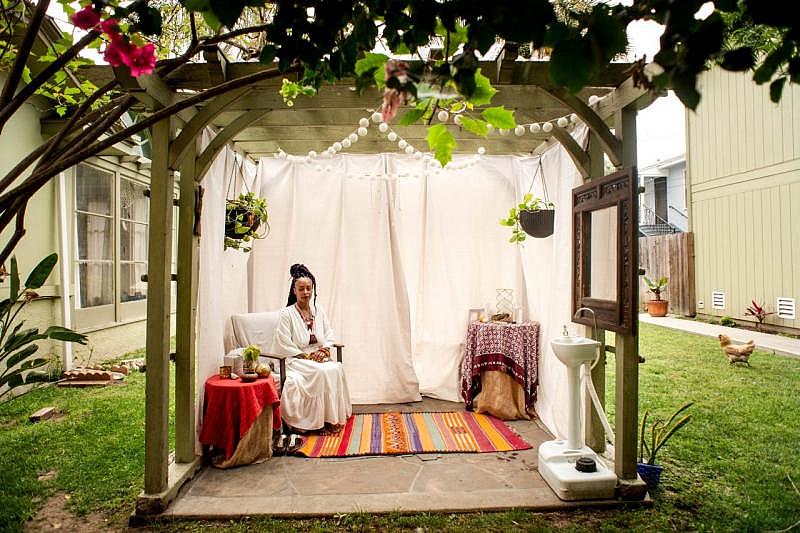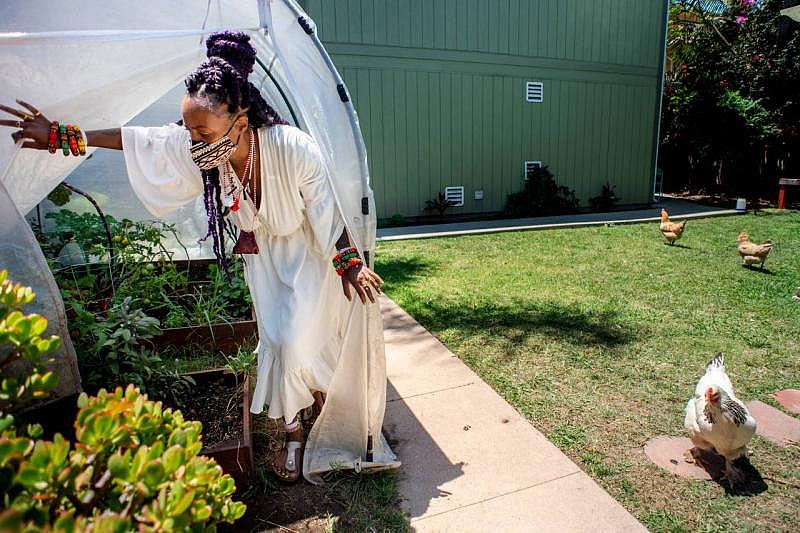Pregnant during Pandemic: Black midwives in demand; are there enough to handle influx of clients?
This is the second in "Pregnant During Pandemic," a series by Olga Grigoryants, a participant in the USC Annenberg Center for Health Journalism’s 2021 California Fellowship.
Her other stories include:
Part 1: Pregnant during pandemic: Programs, midwives step up to support Black mothers
Part 3: Birth centers grow in popularity, but owners say it’s difficult to qualify for state license
Part 4: Pregnant during pandemic: COVID-19 fears fuel increased interest in home births
Part 5: Pregnant during pandemic: Expectant mothers remain at high risk of COVID-19

Midwife Racha Tahani Lawler sits in the space in her garden on Tuesday, July 6, 2021 where she meets with women. She once owned a community birth center but without insurance covering midwifery found it to be difficult to sustain and now does home births.
(Photo by Sarah Reingewirtz, Los Angeles Daily News/SCNG)
In the span of her nearly 20-year career as a licensed midwife who attended hundreds of home births and birth-center deliveries in Los Angeles and Oakland, Racha Tahani Lawler never had a shortage of clients.
Since the beginning of the pandemic, on some days, Lawler would receive 50 to 100 calls. “I started turning families away,” she said. “That’s how busy I was.”
Like many other midwives, Lawler has seen an avalanche of inquiries for a home birth.
The growing awareness of disparities in pregnancy-related deaths for Black women, who are four times more likely to die in Los Angeles County from perinatal complications compared to White women, combined with changing visitation policies in hospitals during the pandemic, has fueled a demand for home birth and Black midwives. But experts say there are not enough of them in Southern California to meet rising demand.
“There’s only a handful of Black midwives in L.A. County and the state,” said Brandi Sims, co-director at Black Maternal Health Center of Excellence at Charles R. Drew University of Medicine and Science, who noted that neighboring counties, such as Orange, might have only one. “It is definitely more challenging to find Black midwives or midwives of color that really know how to provide culturally relevant care.”
About 2% of the country’s 15,000 licensed midwives are Black. In Southern California, there are about 120 licensed midwives, according to the Department of Consumer Affairs website. Only seven of them are Black.
Research shows that midwifery care improves outcomes and the experiences of women and newborns. A recent government study praised midwives for spending more time on education and mental support with Medicaid-enrolled women — areas often not addressed in typical visits with OB/GYNs.
Another study conducted by researchers in 2018 in Canada and the U.S. offered evidence that integrating midwifery care into their health care systems showed some of the best outcomes for mothers and newborns.
The practice has a long legacy in the Black community. Until the end of the 19th century, the majority of births in the U.S. were attended by Black midwives or “grannies.”
They often walked miles to attend births in rural areas where physicians were hesitant to travel. They also spent endless hours with expectant mothers, cooking, cleaning, massaging their feet and reading verses from the Bible. In return, they were paid just a few dollars or given a chicken.
In the early 20th century, obstetricians launched a campaign against grannies, calling them “unsanitary and superstitious” and alleging they were responsible for high infant and maternal mortality rates. But experts say the disappearance of midwifery care was accompanied by the rise of a medical health care system seen as expensive and unequal.
Nonetheless, midwifery remained popular among Black mothers who seek out-of-hospital births, fearing unnecessary C-sections and other potentially traumatic experiences. Studies show White women may obtain better pain assessments after giving birth and have better access to painkillers compared to Black and Latino mothers. Another study conducted by CDC researchers says infants born to college-educated Black mothers were twice as likely to die as infants born to similarly educated White women.
Even megastars such as Beyoncé and Serena Williams, who gave birth a few years ago in a hospital, were not spared from dealing with potentially fatal pregnancy complications.
When Lawler started looking for an apprenticeship, she couldn’t find any Black midwives in Los Angeles. She reached out to white birth workers, she added, but no one was interested in training a Black student.
“I got really frustrated and I started working with an unlicensed Black midwife,” she said. “This is how I got my apprenticeship.”
Midwife Racha Tahani Lawler sits in the space in her garden on Tuesday, July 6, 2021, where she meets with women. She once owned a community birth center but, without insurance covering midwifery, found it to be difficult to sustain and now does home births. (Photo by Sarah Reingewirtz, Los Angeles Daily News/SCNG)
An apprenticeship is an important way to get training in the role of midwives who specialize in out-of-hospital birth. Unlike nurse midwives, who train in nursing before midwifery and often work at hospitals, licensed midwives train with a preceptor, who supervises them during prenatal, labor, birth and postpartum visits at clients’ homes.
After attending a midwifery school in Texas where she received a scholarship, Lawler returned to Los Angeles and spent years attending home births. Knowing how important apprenticeship is in training for midwifery, she dedicated herself to mentoring student midwives of color.
She said some of her clients were Black families who saw a home birth as their only option because they worried about being treated unfairly in hospitals.
“I have clients who don’t want to do home birth,” she said. “But their fear of the hospital overrides their fear of birthing at home.”
During her visits, which often stretched to more than an hour, Lawler talked with her clients not just about pregnancy but also about water intake, access to healthy food and mental health. She has assisted women whose insurance didn’t cover home birth and offered discounts to families who couldn’t pay thousands of dollars out of pocket.
“It’s all a full circle for me with growing the food, feeding people and growing the babies, getting the babies out, and supporting the families,” she said. “Midwifery is about all of this.”
As she prepares for a home birth with her clients, Lawler said she spends hours “educating and communicating about all the different aspects of pregnancy and prenatal care and all the things that could go wrong. … We have a plan for if they go into labor on the freeway. We have a plan for everything.”
Studies show that the risk of perinatal death associated with home birth attended by a midwife is low and has no significant differences from that of planned hospital birth.
Black families face unique challenges, she said, and “there are different barriers and caveats and just differences in how Black people move and how Black people sustain themselves and support themselves. A lot of Black midwives are making up those variances and differences.”
Midwife Racha Tahani Lawler started growing vegetables and raising chickens, so she could fill her clients’ bags with fresh produce and eggs during their visits in her backyard.(Photo by Sarah Reingewirtz, Los Angeles Daily News/SCNG)
After she realized that some of her expectant mothers didn’t have a backyard and struggled to venture outdoors amid pandemic-related restrictions, she installed a tent in her backyard with a sink and comfortable chair, and invited her clients and their partners to spend time there, soaking up some sun, meditating or just taking a nap. She also started growing vegetables and raising chickens, so she could fill her clients’ bags with fresh produce and eggs on their way home.
As protests against police brutality erupted across the region last year, Lawler said many of her clients displayed signs of perinatal depression.
An estimated 800,000 women in the U.S. are affected by perinatal depression, which increases a woman’s risk of becoming suicidal or harming her newborn.
“A lot of my Black clients were suffering and worrying about their spouses and partners,” she said. “If they had to run errands, they worried about them being pulled over by the police and being harmed.”
It was not uncommon for her clients to say they were dealing with three pandemics.
“We were fighting systemic racism and we were fighting police brutality and we were fighting the pandemic,” she said. “And for some of my clients, it was just too much; it was super overwhelming.”
Since establishing her private practice in 2001, Lawler has been training as many midwives of color as possible. But while supporting them has been important, she said, “It can’t be the responsibility of Black midwives to save Black families. There needs to be accountability and responsibility in the hospitals.”
There are families that want to have midwifery care in the hospital, or have high-risk pregnancies, she said, and are discouraged from having a birth at home. Those families still need health care providers who would take good care of them.
Debbie Allen, founder of Tribe Midwifery, is another licensed midwife who has been dedicated to training students of color while handling an influx of phone calls from pregnant women.
“A Black woman should go to any midwife and feel seen, heard, cared for understood and not judged,” Allen said. “But, unfortunately, they feel that they can only get that with a Black midwife.”
Sims, of Charles R. Drew University, said she saw a growing interest among young Black women considering a career in midwifery care as they were “connecting the dots between their own current experiences with medical providers and then the growing awareness of birth disparities.”
One of the reasons there are not many midwives of color, Sims said, is because the midwifery programs can be expensive and take years to complete. It’s important for universities and schools of medicine to create midwifery programs, she added, which would not only help potential student midwives to apply for a student loan but would also build relationships between midwives and other health providers.
Still, Lawler said it’s crucial to train as many midwives of color as possible.
“What should be even more important,” she said, “is that Black people receive midwifery care or any type of prenatal care that they can access and feel safe and be respected and not worrying about dying or worrying about their baby dying.”
This article was produced as a project for the USC Center for Health Journalism‘s 2021 California Fellowship.
[This article was originally published by Los Angeles Daily News.]
